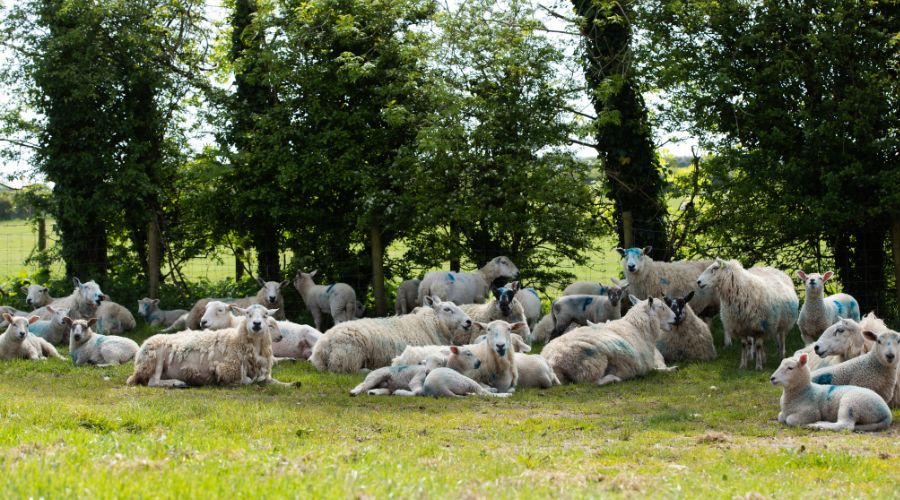How to manage parasite risks in lambs this spring
26th March 2025
Farmers Guide speaks to Elanco’s ruminant technical consultant, Matt Colston, about the key parasites of concern for lambs in the early spring.

Vigilance for signs of nematodirus and coccidiosis, and early preventative action against blowfly strike, are key to maintaining health and performance in lambs.
Increasingly variable weather conditions have highlighted the importance of closely monitoring flocks for parasites, with peak risk periods changing year on year.
Matt Colston, ruminant technical consultant at Elanco, says the key parasite concerns in the early spring include nematodirus, coccidiosis, and blowfly strike.
“After putting in the effort to give lambs the best start – optimising ewe nutrition during pregnancy and ensuring lambs receive adequate colostrum – making sure they get enough milk from their mothers will mean this work was not in vain,” he says.
Therefore, while it might seem obvious, a good starting point is avoiding any nutritional deficiencies in ewes during the first few weeks after lambing, especially if the grass is slow to come.
“In the run up to lambing they’ve doubled their maintenance requirement, and that will certainly increase by 50% again when they start milking, so some buffer feeding may be required to ensure they’re not short on energy.”
Nematodirus
Both nematodirus and coccidiosis pose challenges to lambs, especially those between four and eight weeks old.
Mr Colston says the risk factors differ for each, however, clinical signs are similar, with both causing bloody diarrhoea followed by death.
“If you end up with a dead lamb in this age group, a post-mortem is useful to determine the cause,” he adds.
READ MORE: Yorkshire: Influenza of avian origin (H5N1) confirmed in a sheep
READ MORE: Vet urges farmers to test for abortion causes to prevent future losses
“Nematodirus is a ‘lamb crop to lamb crop’ threat on sheep farms,” explains Mr Colston.
“The eggs left by last year’s lambs will mostly stay dormant on the pasture over winter, before hatching in the spring as the weather warms up.
“The impact of this depends on whether lambs have already started grazing or not,” he adds.
Nematodirus larvae only survive on pasture for a relatively short period, so lambs that are not grazing at the time of the hatch may avoid that heavy challenge and the need for treatment.
Therefore, Mr Colston suggests, if possible, to avoid grazing four to eight-week-old lambs where similarly aged lambs were last year, to reduce the risk even further.
“You can accurately determine when this mass hatch is likely to happen on your farm by following the Nematodirus Forecast service from Sustainable Control of Parasites in Sheep (SCOPS),” he adds.
The impact of nematodirus can be sudden, but the forecast helps identify when to target treatments and avoid any losses.
If a nematodirus risk is forecast, or post-mortem results confirm infection, the use of a white wormer is generally recommended, alongside moving lambs to lower-risk grazing, but it is advised to speak to your vet or animal health adviser to confirm the best course of treatment.
Coccidiosis
Unlike nematodirus, coccidiosis is present on most farms, most of the time. Whether lambs suffer disease or reduced growth rates is largely down to flock management and the level of challenge faced by the lambs.
“Adult sheep have pretty good immunity to coccidiosis, but it doesn’t mean they’re not shedding a small number of coccidial oocycts in their dung, so it’s almost always in the environment and inevitable that lambs will become infected at some point,” explains Mr Colston.
“However, ingestion of a low number of oocysts will not cause significant gut damage (or disease), but for every oocyst these naive lambs ingest, they can produce millions more which contaminate the environment.
“Younger lambs in the same group, or the next group to use that pasture, then face a far higher challenge meaning that production losses, disease and even deaths are likely,” he adds.
“That trickle of infection quickly becomes a flood, against which young lambs have little chance of escaping unscathed.”
Mr Colston says strategic treatment for coccidiosis is worthwhile, however timing is key.
“The highest risk period is when lambs are four to eight weeks old and their immunity from colostrum is dwindling,” he explains.
“However, whether or not they get clinical disease depends on the level of challenge – are they in a clean field? Are they in a field that an older group of lambs have grazed?”
Mr Colston says treating adult sheep for coccidiosis will make little or no difference to the disease risk for lambs, so any treatment should be targeted to each group of lambs.
“There are a number of products available, so speak to your vet or animal health adviser to target the right lambs with the right product at the right time,” he explains.
“While worm egg counts can be used to monitor coccidiosis, these should be interpreted with caution and veterinary advice, because a high coccidiosis count does not necessarily equate to a problem.”
Blowfly
As a general rule of thumb, if the weather conditions are right for a nematodirus mass hatch, a blowfly strike will likely not be far behind, says Mr Colston.
He says it is worth considering early preventative treatment, using an Insect Growth Regulator (IGR) product, at the same time lambs are being treated for nematodirus.
“Damage happens fast – it can take as little as 36 hours from an egg being laid on a sheep to maggots eating its flesh – so preventative application is better than waiting to see a struck lamb and treating the whole flock,” adds Mr Colston.
To track blowfly strike risk in your area, Elanco has developed a free tool – Blowfly Watch – which sends regular alerts directly to your inbox. To sign up, please visit https://bit.ly/4kBMbW0
Read more sheep news.



